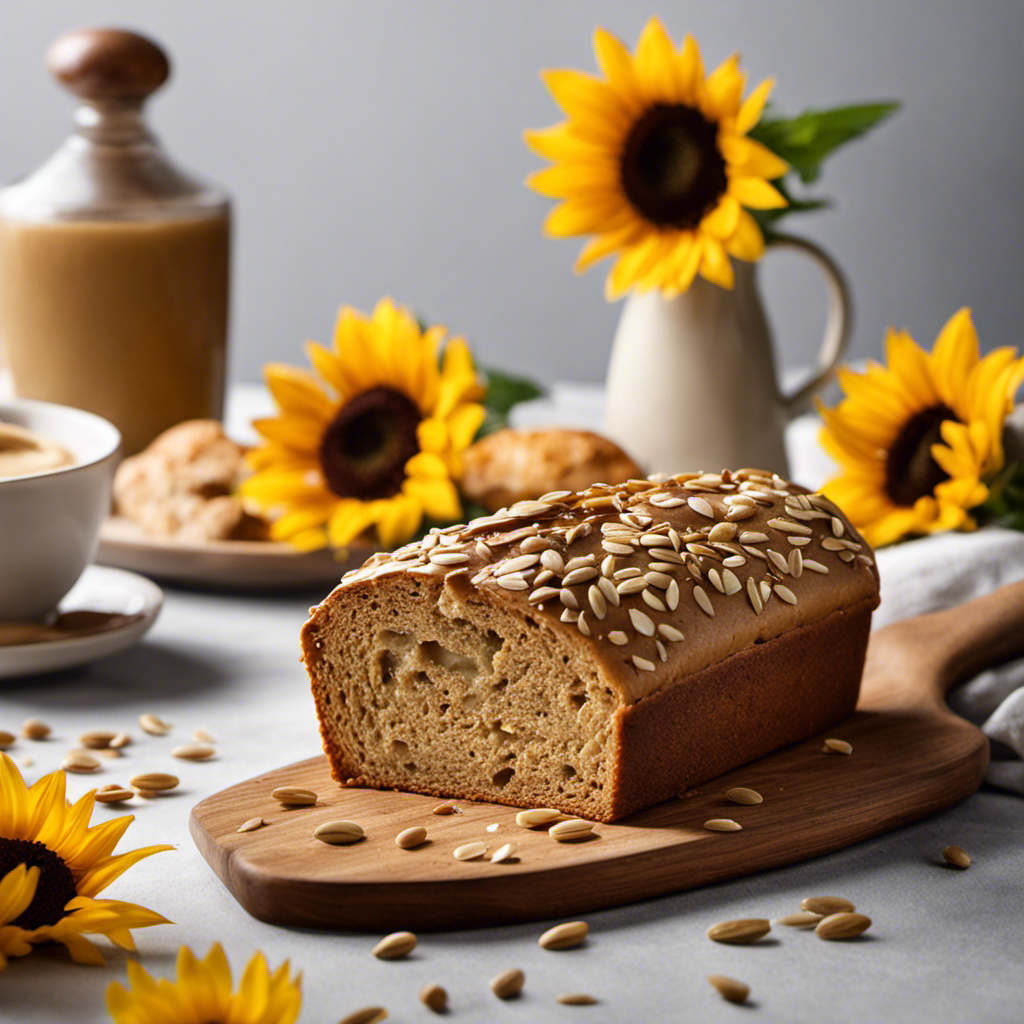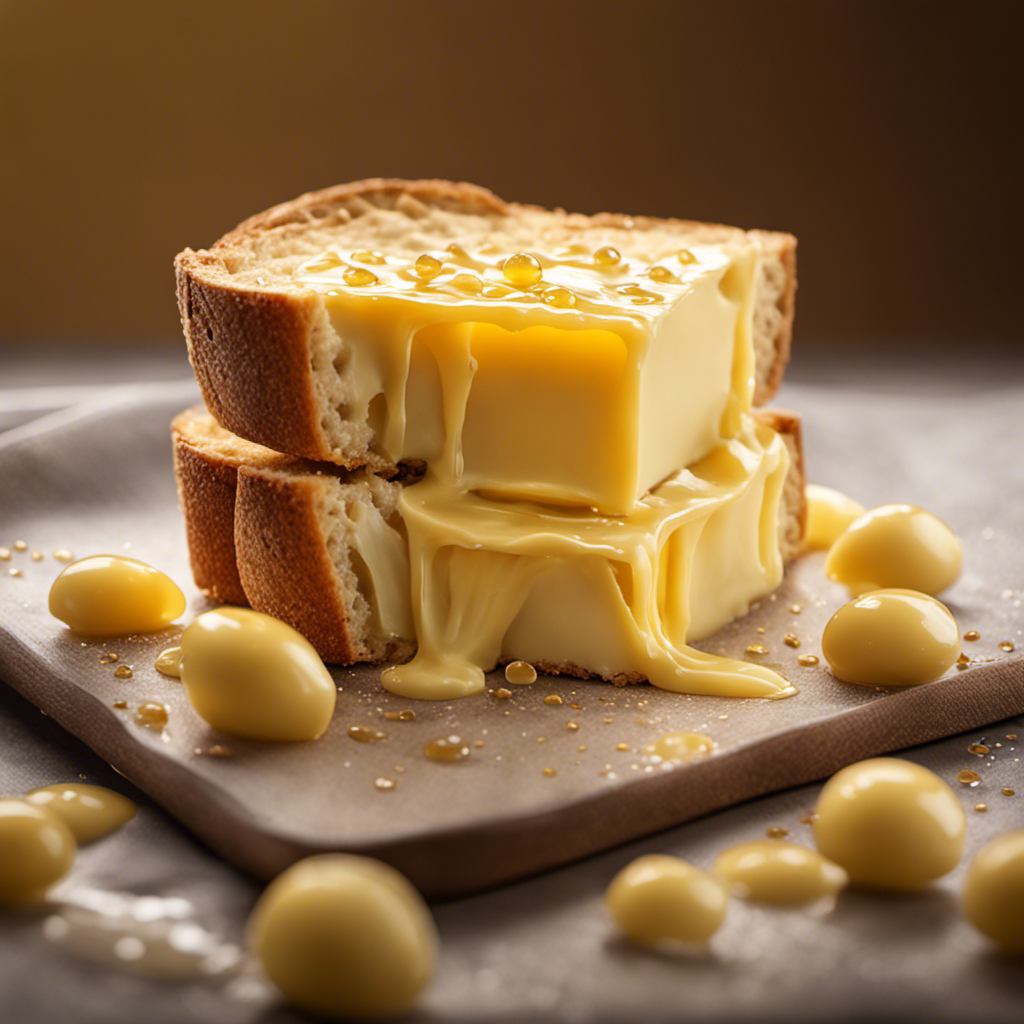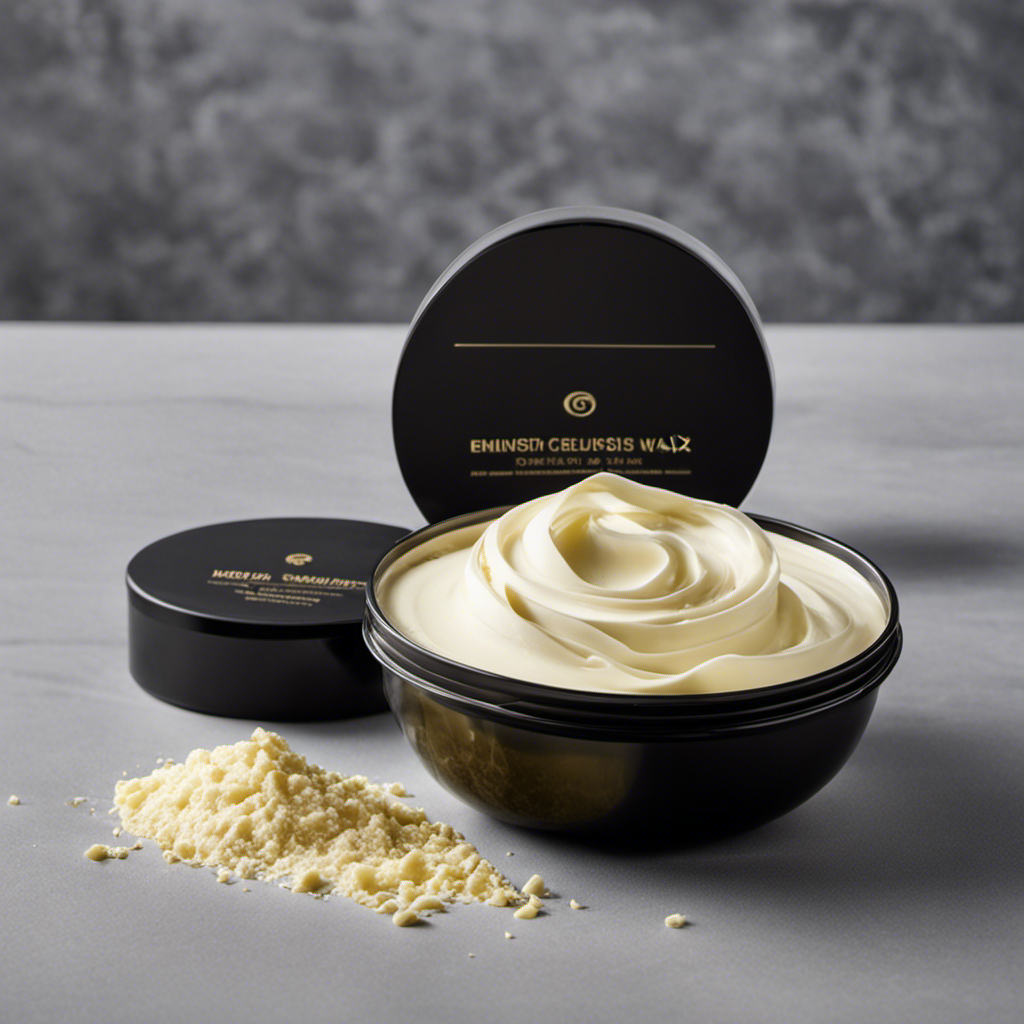Did you ever wonder what sunflower butter tastes like?
Well, let me tell you, it’s like a burst of nutty and rich flavor that dances on your taste buds.
The creamy and smooth texture oozes with mild sweetness, reminiscent of your favorite childhood peanut butter.
But here’s the twist – it also brings earthy undertones and slightly roasted notes that add depth and complexity.
Trust me, this versatile spread is a game-changer in cooking and baking.
Get ready to experience a whole new level of deliciousness!
Key Takeaways
- Sunflower butter has a distinct nuttiness resembling roasted sunflower seeds.
- It is a delicious alternative to traditional nut butters.
- Sunflower butter’s flavor shines through in various recipes.
- Sunflower butter spreads effortlessly and has a luscious and velvety feel.
Nutty and Rich Flavor
Sunflower butter has a nutty and rich flavor that makes it a delicious alternative to traditional nut butters. As someone with a nut allergy, finding a nut-free alternative has been a game-changer for me.
The taste of sunflower butter is incredible. It has a distinct nuttiness that resembles the flavor of roasted sunflower seeds. The richness of the butter adds a creamy and smooth texture to any dish. Whether I spread it on toast, use it as a dip for fruits, or incorporate it into baked goods, the flavor always shines through.
Not only does sunflower butter taste amazing, but it also has numerous health benefits. It is packed with vitamins, minerals, and healthy fats, making it a nutritious choice.
Creamy and Smooth Texture
You’ll love the creamy and smooth texture of sunflower butter. It spreads effortlessly on toast, giving it a luscious and velvety feel in every bite.
As an alternative to peanut butter, it offers a rich and satisfying experience without any overpowering flavors. The creamy consistency makes it easy to incorporate into various recipes, from smoothies to baked goods.
Its smoothness enhances the overall taste of any dish it is added to, creating a delightful mouthfeel. Sunflower butter’s texture is perfect for those who prefer a smoother spread that effortlessly glides on the palate.
And the best part is, this creamy goodness is accompanied by a mild sweetness that adds a touch of indulgence to every bite.
Mild Sweetness
When it comes to the nutty flavor profile of sunflower butter, I must say that it’s simply delightful. It has a rich and distinct taste that is reminiscent of peanut butter, but with its own unique twist.
The flavor is bold, yet not overpowering, making it a versatile taste option that can be enjoyed in a variety of ways. Whether spread on toast, mixed into smoothies, or used in baking, sunflower butter adds a delicious and satisfying element to any dish.
Nutty Flavor Profile
The nutty flavor of sunflower butter is similar to that of other nut butters. It has a rich, earthy taste that is slightly sweet and slightly savory. When you spread it on a piece of toast or dip a carrot stick in it, the flavor explodes in your mouth. It’s like a burst of sunshine and happiness.
What I love about sunflower butter is that it is a perfect nut-free alternative for those with allergies. It provides a similar taste and texture to traditional nut butters without the risk of an allergic reaction. Plus, it has numerous health benefits.
Sunflower butter is packed with vitamins and minerals, like vitamin E and magnesium, which support overall health and wellbeing. So not only does it taste amazing, but it’s also good for you!
Similar to Peanut Butter
Sunflower butter, similar to peanut butter, is a versatile spread that can be used in a variety of ways. As a substitute for peanut butter, it offers a unique twist to classic recipes. But what sets sunflower butter apart? Let me share my thoughts. Firstly, its health benefits are remarkable. Packed with essential nutrients like vitamin E and magnesium, it promotes heart health and aids in digestion. Additionally, it is a great source of protein and healthy fats, making it a perfect choice for those following a vegan or gluten-free diet. To give you a clearer picture, here’s a handy table:
| Nutrient | Amount per serving |
|---|---|
| Vitamin E | 4mg |
| Magnesium | 85mg |
| Protein | 7g |
| Healthy Fats | 16g |
| Fiber | 3g |
With all these benefits, sunflower butter is not only a healthy option, but it also offers a rich and creamy texture that is comparable to peanut butter. It spreads smoothly on toast, adds a nutty flavor to smoothies, and can even be used as a dip for fruits and vegetables. Trust me, you won’t be disappointed with this versatile taste option. Now, let’s explore its unique flavor profile in more detail.
Versatile Taste Option
Its versatility makes it a go-to option for adding flavor and texture to a variety of dishes. Sunflower butter is not only a delicious spread for toast or crackers, but it can also be used in numerous other ways. Here are three reasons why sunflower butter is a versatile choice:
-
Perfect for sandwiches: Sunflower butter has a rich, nutty flavor that pairs well with a wide range of sandwich ingredients. Whether you prefer a classic PB&J or want to experiment with savory combinations like turkey and sunflower butter, this spread adds a unique twist to any sandwich.
-
Alternative to peanut butter: For those with peanut allergies or dietary restrictions, sunflower butter is an excellent substitute. It offers a similar creamy consistency and can be used in recipes that call for peanut butter, allowing you to enjoy the same great taste without the risk of an allergic reaction.
-
Adds depth to recipes: Sunflower butter can be incorporated into both sweet and savory recipes, adding depth and richness to dishes. From smoothies and sauces to baked goods and dressings, its unique flavor profile elevates the taste of any recipe.
In my opinion, sunflower butter is a versatile and delicious option that deserves a place in every pantry. Its ability to enhance sandwiches and serve as an alternative to peanut butter makes it a must-try ingredient for anyone looking to add a new twist to their favorite dishes.
Similar to Peanut Butter
You’ll find that sunflower butter tastes similar to peanut butter. As a nut-free alternative, sunflower butter provides a delicious option for those with allergies or dietary restrictions. The taste is rich and nutty, with a creamy texture that spreads effortlessly on toast or pairs perfectly with jelly in sandwiches. It has a slightly sweet and savory flavor, reminiscent of roasted sunflower seeds.
I love that it offers all the health benefits of sunflower seeds, such as being a good source of protein, fiber, and healthy fats. Plus, it contains vitamins and minerals like vitamin E, magnesium, and selenium. The smooth and velvety consistency makes it easy to incorporate into recipes, from smoothies to baked goods.
Now, let’s delve into its earthy undertones.
Earthy Undertones
Sunflower butter is a delectable spread that boasts a rich and nutty flavor profile. It is smooth and creamy, making it a perfect alternative to traditional nut butters.
Not only is it delicious on toast or in sandwiches, but it is also a versatile cooking ingredient. It can be used in both sweet and savory dishes, adding a delightful depth of flavor.
Nutty Flavor Profile
If you’re a fan of nutty flavors, you’ll love the taste of sunflower butter. It has a rich aroma and a unique aftertaste that sets it apart from other nut butters. Here’s why you should give it a try:
-
Creamy and smooth: Sunflower butter has a velvety texture that spreads effortlessly on toast or crackers.
-
Roasted goodness: The sunflower seeds are carefully roasted to enhance their natural flavors, resulting in a delightful nuttiness that is both satisfying and comforting.
-
Subtle sweetness: While sunflower butter is not as sweet as some other nut butters, it has a hint of natural sweetness that adds depth to its flavor profile.
When I first tried sunflower butter, I was blown away by its rich and aromatic taste. It has a distinct nuttiness that is both familiar and unique. The aftertaste lingers on the palate, leaving a pleasant and satisfying sensation.
Trust me, once you try sunflower butter, you’ll be hooked on its delicious nutty goodness.
Smooth and Creamy
If you’re looking for a nut-free alternative that still delivers that smooth, creamy goodness, look no further than sunflower butter. Let me tell you, this spreadable delight is a game-changer.
As soon as you open the jar, you’re greeted with a rich aroma that hints at the deliciousness within. The texture is velvety smooth, making it perfect for spreading on toast, dipping apples, or even just enjoying by the spoonful.
And the taste? Oh, it’s simply divine. With a slightly sweet and nutty flavor, sunflower butter is a true delight for the taste buds. It’s like a burst of sunshine in every bite.
Trust me, once you try this nut-free alternative, you won’t miss traditional nut butters at all.
Versatile Cooking Ingredient
You’ll be amazed at the countless ways you can incorporate this creamy spread into your favorite recipes. Sunflower butter, a delicious and nutritious vegan alternative to traditional nut butters, is not only incredibly versatile but also offers a variety of health benefits.
Here are three reasons why you should consider adding sunflower butter to your pantry:
-
Rich in nutrients: Sunflower butter is packed with essential vitamins and minerals, including vitamin E, magnesium, and selenium. These nutrients contribute to healthy skin, strong bones, and a strong immune system.
-
Heart-healthy fats: Unlike butter made from animal products, sunflower butter is rich in unsaturated fats, which are beneficial for heart health. These fats help to lower bad cholesterol levels and reduce the risk of cardiovascular diseases.
-
Allergy-friendly: Sunflower butter is a great alternative for those with nut allergies, as it is made from sunflower seeds rather than nuts. It provides the same creamy texture and nutty flavor, making it a perfect substitute in recipes and snacks.
Incorporating sunflower butter into your favorite recipes not only adds a delicious and unique flavor, but also provides numerous health benefits. Whether you spread it on toast, add it to smoothies, or use it as a dip for fruits and vegetables, sunflower butter is a versatile and nutritious ingredient that will enhance your meals in more ways than one.
Slightly Roasted Notes
You can taste the slightly roasted notes in sunflower butter, giving it a unique flavor profile. When you take a spoonful of this creamy spread, the first thing that hits your taste buds is the nuttiness. It’s like biting into a roasted seed alternative, but with a smoother texture.
The roasting process enhances the natural flavors of the sunflower seeds, bringing out a rich and toasty essence. As you savor the butter, you can detect hints of sweetness and a subtle earthiness that adds depth to its overall taste. It’s a delightful combination of flavors that makes sunflower butter stand out from other nut or seed spreads.
And this unique flavor profile makes it incredibly versatile for cooking and baking, adding a distinct twist to both sweet and savory dishes.
Versatile for Cooking and Baking
When cooking or baking, you can explore a wide range of recipes using sunflower butter due to its versatility. Here are three great ways to incorporate sunflower butter into your culinary creations:
-
Sunflower butter as a vegan alternative in baking: As a vegan myself, I’m always on the lookout for delicious plant-based substitutes. Sunflower butter is a perfect replacement for traditional butter in baking recipes. Its creamy texture and nutty flavor add depth to cookies, brownies, and cakes, making them irresistibly moist and rich.
-
Incorporating sunflower butter into savory recipes: Don’t limit sunflower butter to just sweet treats! It can also be a fantastic addition to savory dishes. I love using it in sauces, dressings, and dips to add creaminess and a hint of nuttiness. It pairs wonderfully with roasted vegetables, stir-fries, and even curries.
-
Sunflower butter as a spread: Forget traditional peanut butter, sunflower butter makes an excellent spread for toast, bagels, or sandwiches. Its smooth consistency and subtly sweet taste make it a versatile choice for breakfast or a quick snack.
Frequently Asked Questions
How Is Sunflower Butter Different From Other Nut Butters Like Almond or Cashew Butter?
Sunflower butter has a unique taste compared to almond or cashew butter. It’s slightly nutty with a hint of sweetness. In terms of nutrition, it has more vitamin E and less saturated fat than most nut butters.
Can Sunflower Butter Be Used as a Replacement for Peanut Butter in Recipes?
Sunflower butter can be a delicious replacement for peanut butter in recipes. It has a smooth and creamy texture, with a slightly nutty and earthy flavor. I love using it in baking, especially in cookies and muffins.
Does Sunflower Butter Have Any Health Benefits?
Sunflower butter is a nutritious alternative to peanut butter. It is packed with vitamins and minerals, making it a healthy choice for weight management. Plus, it has a deliciously rich and nutty flavor.
Is Sunflower Butter Safe for People With Nut Allergies?
As someone with a nut allergy, I’ve found sunflower butter to be a safe alternative. It’s creamy, nutty, and delicious. I’ve never experienced any allergic reactions, making it a great option for those with sensitivities.
What Are Some Creative Ways to Incorporate Sunflower Butter Into Meals and Snacks?
There are so many creative recipes to make with sunflower butter! It adds a delicious nutty flavor to smoothies, cookies, and even savory dishes like stir-fries. Plus, the benefits of sunflower butter are amazing for your health!
Conclusion
In conclusion, sunflower butter is a delightfully delicious alternative to traditional nut butters. Its nutty and rich flavor, combined with a creamy and smooth texture, make it a delightful spread for toast, sandwiches, or even as a dip for fruits and vegetables.
The mild sweetness adds a pleasant touch, while the earthy undertones and slightly roasted notes give it a unique and satisfying taste. Whether you’re a fan of peanut butter or not, sunflower butter is sure to win you over with its versatility and mouthwatering taste.
It’s like a ray of sunshine on your taste buds, bringing a burst of flavor to every bite.










